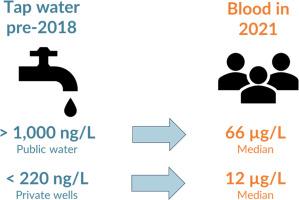废弃造纸厂附近社区自来水和血清中的全氟和多氟烷基物质(PFASs)升高
Q2 Environmental Science
引用次数: 0
摘要
2018年,市政井中发现全氟烷基和多氟烷基物质(PFASs)浓度升高(1600纳克/升),地下水污染与密歇根州西南部一个废弃的造纸厂垃圾填埋场有关。从2020年至2021年,我们在该社区进行了详细的暴露评估,以提供有关饮用水中来自造纸厂源的全氟辛酸混合物及其长期暴露后在人类血清中的持久性的见解。采用LC-MS/MS分析水和血清中PFASs的含量。与市政用水(1600纳克/升)相比,大约一半的研究参与者的私人水井的PFAS浓度(220纳克/升)较低,因此,他们被划分为低(私人水井)和高(市政水井)暴露组。城市井中检测到的三种主要全氟辛烷酸(PFOA) (670 ng/L)、全氟辛烷磺酸(PFOS) (740 ng/L)和全氟己烷磺酸(PFHxS) (19 ng/L)在血清中含量也最高。高饮用水暴露的参与者血清中PFOA、PFOS和PFHxS的浓度分别比低饮用水暴露组高15倍、5倍和2倍。参与者每多喝一年市政用水,我们观察到血清PFOA、PFOS和PFHxS分别增加6%、4%和5%。总的来说,这些结果突出了饮用水作为全氟化砷暴露的主要来源的作用,以及废弃的垃圾填埋场可能对附近社区的饮用水造成的风险。本研究还建立了长期毒理学影响和干预效果评估的基线。本文章由计算机程序翻译,如有差异,请以英文原文为准。

Elevated per- and polyfluoroalkyl substances (PFASs) in tap water and serum in a community near an abandoned paper mill
In 2018, elevated concentrations of per- and polyfluoroalkyl substances (PFASs) (1600 ng/L) were discovered in municipal wells, and the groundwater contamination was linked to an abandoned paper mill landfill in southwestern Michigan. From 2020-2021, we conducted a detailed exposure assessment in this community to provide insights about the mixture of PFASs from a paper mill source in drinking water and their persistence in human serum following long-term exposure. Water and serum were analyzed for >30 PFASs using LC-MS/MS. Approximately half of the study participants had private wells with lower PFAS concentrations (<220 ng/L) compared to municipal water (1600 ng/L), therefore, they were assigned as low (private well) and high (municipal well) exposure groups. The three predominant PFASs detected in the municipal well, perfluorooctanoic acid (PFOA) (670 ng/L), perfluorooctane sulfonic acid (PFOS) (740 ng/L), and perfluorohexane sulfonic acid (PFHxS) (19 ng/L), were also the most abundant in serum. Participants with high drinking water exposure had serum PFOA, PFOS and PFHxS concentrations that were 15-fold, 5-fold, and 2-fold higher, respectively, compared to those in the low group. For each additional year participants reported drinking the municipal water, we observed a 6 %, 4 %, and 5 % increase in serum PFOA, PFOS and PFHxS, respectively. Overall, these results highlight the role of drinking water as a predominant source of PFAS exposure and the risk that abandoned landfills can pose to drinking water in nearby communities. This study also establishes a baseline for long-term toxicological impacts and evaluation of intervention effectiveness.
求助全文
通过发布文献求助,成功后即可免费获取论文全文。
去求助
来源期刊

Environmental Advances
Environmental Science-Environmental Science (miscellaneous)
CiteScore
7.30
自引率
0.00%
发文量
165
审稿时长
12 weeks
期刊介绍:
 求助内容:
求助内容: 应助结果提醒方式:
应助结果提醒方式:


